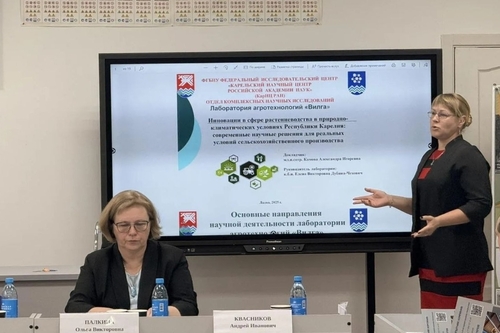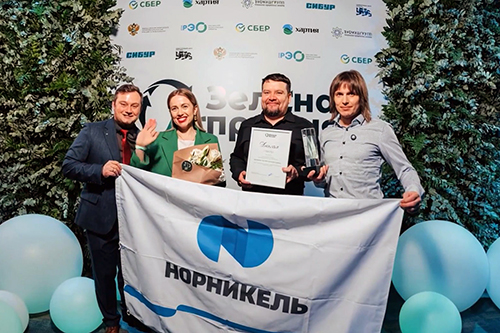– This topic is in line with one of the research areas of the History Section of our Institute, namely the study of the socio-economic situation of peasants in the post-reform period. It is also of some interest to the public. Today, one can find remnants of peasant infrastructure, in particular, water mills, on streams even deep in the woods. Our intent is to show everyone that history is much closer to us than we sometimes imagine, – shared one of the project participants, Researcher at the Institute of Linguistics, Literature and History KarRC RAS Alexander Krivonozhenko.
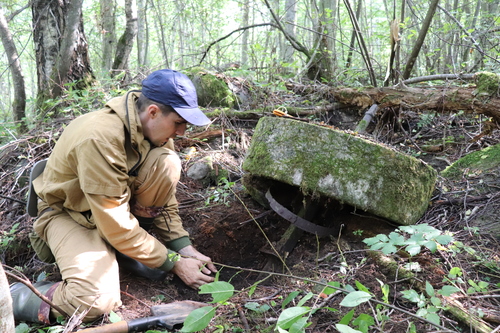
Historian Alexander Krivonozhenko unearths preserved details of a mill mechanism
The scientist specializes in agrarian history and has previously covered the topic of peasant mills as a source of welfare for peasants in academic publications. Within this project, the historian works in archives and libraries of Petrozavodsk and Vologda, studies materials related to the topic and uses them in fieldwork, which focuses on the Kondopoga District. The appearance of one of the mills that used to stand on a stream near the village of Käppeselga is going to be recreated in the form of a model partially using historical techniques and materials.
– Mills were an indispensable attribute of daily economic peasantry practices. In essence, they were an integral element in the process of making bread, the main foodstuff for the rural population. The title of our project reflects their importance. Unfortunately, they rarely get into the focus of interest for historians and anthropologists, – Alexander Krivonozhenko remarked.
The questions of forest landscape and timber processing are addressed in the project by Vladimir Karpin, Researcher at the Forest Research Institute KarRC RAS. According to the scientist, the forest has always been close to economic activities in the context of land use history. Today, it helps complete and visualize the image of the world that existed in the area during the previous centuries.
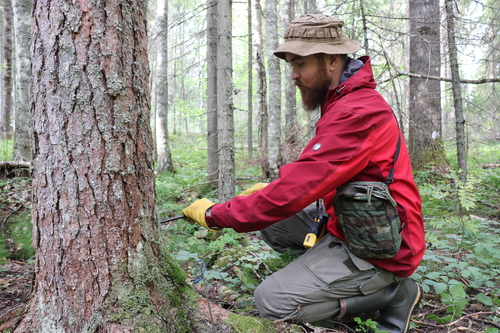
Researcher at the Forest Research Institute KarRC RAS Vladimir Karpin determining tree age in the study area
The scientists have already made the first expedition to the sites located by studying historical documents, and could compare the different types of terrain harboring the peasant mills.
– We visited two brooks associated with different settlements and saw that the mills could have very different siting. In the first case, it was essentially thick forest without any signs of economic activity. By now, it has regained its near original appearance. In the second case, the territory adjacent to the mill was, in all evidence, actively used in agriculture: there are stone cairns in the immediate vicinity, the arable layer is quite fertile, the tree species composition is mainly small-leaved, low-productive gray alder communities, with almost no conifers and rare birch trees. This means the mill was located amid agrarian lands, in an open cultivated area. The main provision in both cases is the presence of water power, i.e. a suitable stream, – told Vladimir Karpin.
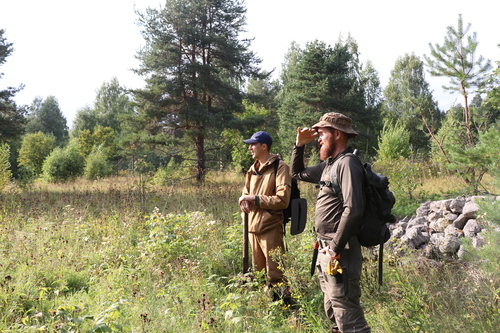
The scientists examined the surroundings of abandoned villages
The results of the research and historical details will be reflected in the outputs intended for the general public. A model of a water mill is going to be donated to the Kondopoga Area Museum, and thematic exhibitions will also appear in the district's museums. Offline educational events will be held in the village of Käppeselga, Kondopoga and the Museum of Applied Environmental Research of KarRC RAS in Petrozavodsk. Media materials will be published on the project website, in social networks and regional media outlets.





